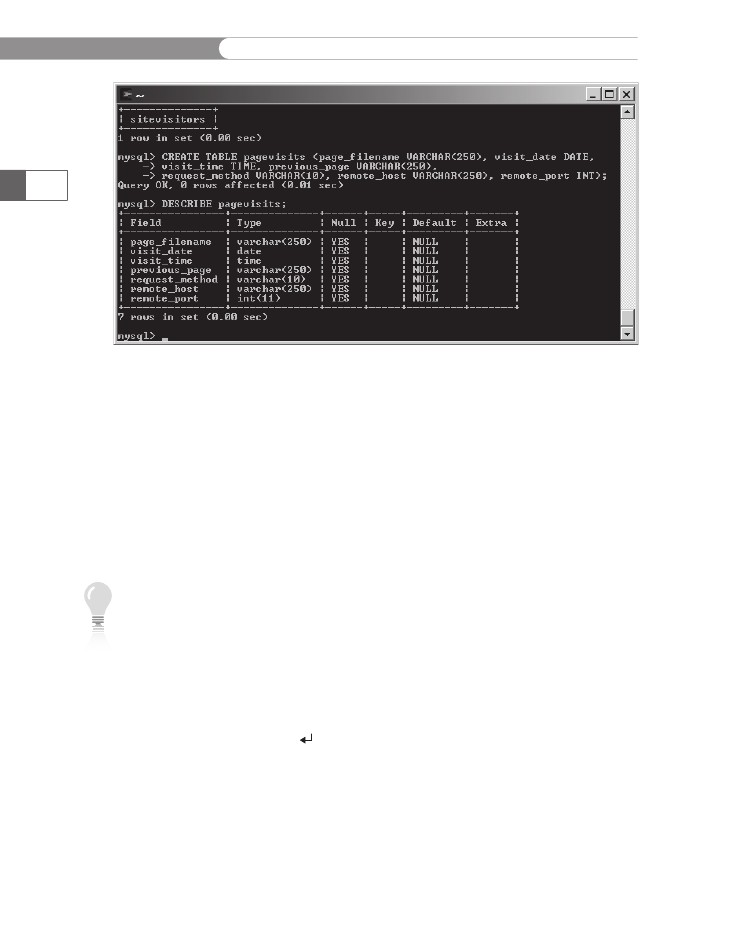
- •Initializing with Constructor Functions . . . . .
- •Into a Web page as a separate section. Although JavaScript code can
- •Is that standard php script delimiters are guaranteed to be available
- •In the block. Any text or lines between the opening /* characters and
- •2.7541 Are not integers; they are floating-point numbers. A floating-
- •Value 300
- •Is a value of 2.5, because 6 goes into 15 exactly 2.5 times. But if you
- •IsEven.Php.
- •Ing example,
- •Ing curly brace is on its own line following the function statements.
- •In php 3 and earlier, it was necessary to put a function definition
- •Is called an iteration. When the conditional expression evaluates
- •Including Files
- •13. Close your Web browser window.
- •Including Files
- •In php, you can also use two operators to combine strings. The first
- •Xhtml source code gen-
- •Input. Php provides several functions for manipulating the case of a
- •Is uppercase. If you need the reverse of ucfirst(), the lcfirst()
- •In some situations, you will need to find and extract characters and
- •Information Interchange, or ascii, which are numeric represen-
- •In comparison, the following preg_match() function returns a value
- •In the pattern is optional. The following code demonstrates how to
- •Values; any strings you validate against a regular expression must
- •Value of 1 because the top-level domain contains a valid value of .Com.
- •Is submitted using the “post” method, the form data is embedded in
- •Validating String Data
- •Xhtml tags or character entities. The message field is a text string
- •Value of the header element. For example:
- •Xhtml code within a php script section.
- •Is typically the person who created the resource. Otherwise, the net-
- •If even a single character of the Web page is sent prior to sending
- •Variables to the file_put_contents() function.
- •Xhtml hyperlink. To download a file from outside the xhtml
- •If...Else statement to display the appropriate version of the mes-
- •Iterating Through an Array
- •Iterating Through an Array
- •In Chapter 2, you learned how to use a foreach statement to iterate
- •Iterating Through an Array
- •Iterating Through an Array
- •In comparison, the following code declares and initializes
- •If ((!file_exists("MessageBoard/messages.Txt"))
- •Values from the array to create a thumbnail gallery of images in which
- •Introduction to Databases
- •Including php, allow you to create Web pages that can read and write
- •Introduction to Databases
- •Information that can be organized into ordered sets of data, and
- •Information. Each recipe in a recipe database, for instance, is a single
- •Introduction to Databases
- •Index, which identifies records in a database to make retrievals and
- •In a single table. However, you might want to break the information
- •Into multiple tables to better organize it into logical sets. Another
- •Information in one of the tables confidential and accessible only by
- •Is the employee information table from Figure 7-1. The related table
- •Is a payroll table that contains confidential salary and compensation
- •Information. Notice that each table contains an identical number of
- •Introduction to Databases
- •Introduction to Databases
- •In a junction
- •Introduction to Databases
- •In a relational format is called a relational database management
- •Is a standard data manipulation language among many dbmSs.
- •Into the query area at the top of the screen or by dragging tables and
- •It is important to understand that even though many dbmSs sup-
- •Introduction to Databases
- •If you ever
- •Is. In comparison, the bigint data type stores integer values between
- •5 Rows in set (0.00 sec)
- •Int);[enter ]
- •Important, these two tabs can cause you to lose all of the data in the
- •Internet Explorer to export the table, click the Save button in the File
- •Ifies the table being changed and the change to make.
- •It easier for you to write php code that can be used with a variety of
- •Information about queries that match one of the following formats:
- •Various types of actions, depending on the type of query.
- •Include fields for the date and time of the flight, flight number, and
- •In the ChineseZodiac folder and upload the file to the server. Open
- •Including white space,
- •Information on a Web server. When you start a new session, the
- •Introduction to Object-Oriented Programming
- •Introduction to Object-Oriented
- •Variables associated with an object are called properties or attributes.
- •In the Loan object example, a function that calculates the number of
- •Introduction to Object-Oriented Programming
- •Introduction to Object-Oriented Programming
- •Include instances of objects inherit the object’s functionality.
- •In this chapter, you will create the Web site for an online order form
- •In an online store application. The application includes information
- •Ity of building a working online store. Online store classes are very
- •Information and products. The OnlineStore class requires that store
- •Information is stored in a table containing six fields: storeId, name,
- •Information. Instead, the class simply uses session iDs to keep track
- •Variable and function as necessary, without bothering with all this
- •In a class
- •Is developed. Imagine what would happen if Microsoft distributed
- •Ing class is invalid because it does not include an access specifier:
- •If they will not be supported by future xhtml versions or are not
- •Xhtml standards. To review the guide of current w3c css specifi-
- •Information to remind yourself or others of what the code is doing. A
- •Xhtml document to the external style sheet. This link informa-
- •If you select Apache from the WampServer menu and select Service
- •Ing code uses the number_format() function to add comma separa-
- •In data that a user submits to a php script.
- •Value of “On” and the display_startup_errors directive is assigned
- •Instead. By looking at the source code, you could see that the value of
- •Ing engine can even help locate logic errors.
- •In Chapter 8, along with the equivalent mssql_* functions, where
- •Inline styles, 632
- •Xhtml, 620–635 (continued)
To keep your database from growing too large, you should choose the
smallest data type possible for each field. For example, the SMALLINT
data type stores integer values between –32,768 and 32,767 and
occupies 2 bytes of storage space, regardless of how small the value
Is. In comparison, the bigint data type stores integer values between
–9,223,372,036,854,775,808 and 9,223,372,036,854,775,807 and occu-
pies 8 bytes of storage space, no matter how small the value. If you
know that a value you assign to a field will always be between –32,768
and 32,767, you should use the SMALLINT data type instead of the
BIGINT data type, which saves 6 bytes per record. For a single record,
this is not a huge savings, but it could be for a database table with
thousands or even millions of records.
Creating Tables
To create a table, you use the CREATE TABLE statement, which specifies
the table and column names and the data type for each column. The
syntax for the CREATE TABLE statement is as follows:
CREATE TABLE table_name (column_name TYPE, ...);
The following statement creates the vehicles table in the
vehicle_fleet database. The first three columns in the table are
VARCHAR data types; the license field can be a maximum of 10 char-
acters, the make field can be a maximum of 25 characters, and the
model field can be a maximum of 50 characters. The miles field is a
FLOAT data type. The last field, assigned_to, is also a VARCHAR data
type, with a maximum of 40 characters.
mysql> CREATE TABLE vehicles (license VARCHAR(10),[ENTER ]
-> make VARCHAR(25), model VARCHAR(50), miles FLOAT,[ENTER ]
-> assigned_to VARCHAR(40));[ENTER ]
After you create a table, you can use the DESCRIBE statement to dis-
play how the table is structured. The following DESCRIBE statement
displays the structure of the vehicles table below the command:
mysql> DESCRIBE vehicles;[ENTER ]
+-------------+-------------+------+-----+---------+-------+
| Field| Type| Null | Key | Default | Extra |
+-------------+-------------+------+-----+---------+-------+
| license| varchar(10) | YES || NULL||
| make| varchar(25) | YES || NULL||
| model| varchar(50) | YES || NULL||
| miles| float| YES || NULL||
| assigned_to | varchar(40) | YES || NULL||
+-------------+-------------+------+-----+---------+-------+
5 Rows in set (0.00 sec)
You can exe-
cute the SHOW
TABLES
statement to
display a list
of the tables in the cur-
rent database.
The result of the preceding DESCRIBE vehicles; command showed
six columns, not just the two for Field and Type. The other four

Defining
Database Tables
columns
show special characteristics or restrictions on the fields
that
can be defined in MySQL. The values for these columns can be
specified
in the CREATE
TABLE statement.
The Null column indicates
whether
the field can be left empty or not. The Key field indicates
which
type of key, if any, is defined for the field (PRIMARY,
UNIQUE,
or
INDEX).
The Default column shows the value that will be inserted
automatically
in the field if no value is specified. The Extra col-
umn
indicates any special features about the field, such as an auto-
increment
value.
Next,
you will create a table named pagevisits
in
the sitevisitors
database.
The table will contain detailed information about every
visit
to a Web page on your site. The table will contain seven
fields:
page_filename,
visit_date,
visit_time,
previous_page,
request_method,
remote_host,
and remote_port.
The visit_date
field
will be a DATE
data
type, the visit_time
field
will be a TIME
data
type,
the remote_port
field
will be an INTEGER
data
type, and the
rest
of the fields will be VARCHAR
data
types. Note that the TIME
data
type
can be used to store a specific time or a measure of time. In the
pagevisits
table,
the visit_time
field
will contain the duration of
each
visit. For the DATE
data
type, dates must be entered in the for-
mat
YYYY-MM-DD;
for the TIME
data
type, times must be entered in the
format
HH:MM:SS.
To
create the pagevisits
table:
1.
2.
405
Return
to MySQL Monitor.
Enter
the following command to select the sitevisitors
database:
mysql>
USE sitevisitors;[ENTER ]
3.
Enter
the following command to create the pagevisits
table:
mysql>
CREATE TABLE pagevisits (page_filename
VARCHAR(250),
visit_date DATE,[ENTER ]
->
visit_time TIME, previous_page
VARCHAR(250),[ENTER ]
-> request_method VARCHAR(10), remote_host
VARCHAR(250), remote_port INT);[ENTER ]
4.
After you see the “Query OK” message, enter the following
command to view the structure of the new table. Your screen
should look like Figure 7-9.
mysql> DESCRIBE pagevisits;[ENTER ]

CHAPTER
7
Working
with Databases and MySQL
406
Figure
7-9
DESCRIBE
statement
displaying the structure of the pagevisits
table
Altering
Tables
Over
time, the original table definition may not be sufficient for your
needs.
New fields may be needed, existing fields may become obso-
lete,
or the field modifiers may no longer be appropriate. To modify
the
structure of a table, you use the ALTER
TABLE statement.
The state-
ment
has several different syntaxes, depending on the change being
made.
The
keyword
COLUMN is
required for
standard SQL,
but not for
MySQL. When adding a
single column, the paren-
theses around the list of
column_name and
column_type specifiers
are optional.
Adding Columns
To add fields to a table with the ALTER TABLE statement, use the
following syntax:
ALTER TABLE table_name ADD [COLUMN] (column_name column_
type [, column_name column_type ...]);
The following statement adds a new column of type INT named
model_year to the vehicles table in the vehicle_fleet database:
